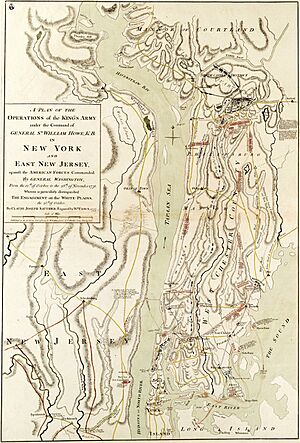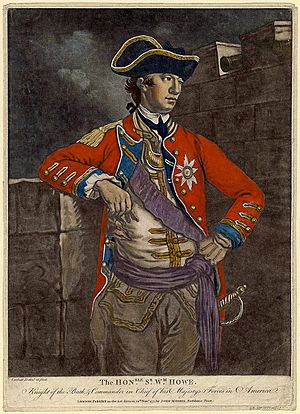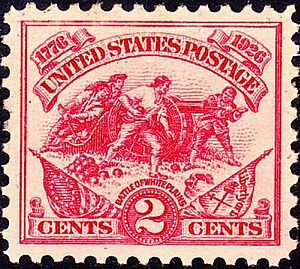Battle of White Plains facts for kids
Quick facts for kids Battle of White Plains |
|||||||
|---|---|---|---|---|---|---|---|
| Part of the American Revolutionary War | |||||||
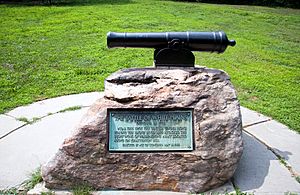 Battle of White Plains Historic Site |
|||||||
|
|||||||
| Belligerents | |||||||
| Commanders and leaders | |||||||
| Strength | |||||||
| 4,000–7,500 | 3,100 | ||||||
| Casualties and losses | |||||||
| 47 killed 182 wounded 4 missing |
50–150+ killed 150+ wounded 1 missing 16 captured |
||||||
The Battle of White Plains was an important fight during the American Revolutionary War. It happened on October 28, 1776, near White Plains, New York. After losing battles in New York City, General George Washington led his American Continental Army north. British General William Howe tried to trap Washington's army. Washington moved his troops to White Plains and set up defenses. However, the British managed to push the Americans off a key hill. After this loss, Washington ordered his army to retreat further north.
This battle was part of a larger plan by the British to control New York. Even though the Americans lost this battle, Washington's ability to keep his army together was a big deal. Later, he would lead his troops to surprise victories, like the Battle of Trenton.
Contents
Why the Battle Happened
In 1776, the British wanted to take control of New York City. General William Howe led the British army. They landed on Staten Island and then Long Island. After the Battle of Long Island, General Washington and his 9,000 American soldiers escaped to Manhattan.
The British followed and landed on Manhattan. Washington's army fought them at Harlem Heights. General Howe then tried to surround Washington's army. He landed troops north of New York City, in Westchester County. His goal was to cut off Washington's escape route.
Getting Ready for the Fight
Washington quickly realized the danger. He sent his troops to White Plains. This was a good place to defend, and it had important American supplies. Washington left about 1,200 men to defend Fort Washington in Manhattan.
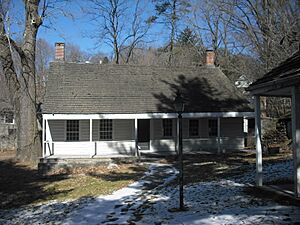
Washington set up his headquarters at the Elijah Miller House. He built two lines of trenches for defense. These trenches were on high ground. A swamp protected one side, and steep hills were behind them for a retreat. The American defenses stretched for about 3 miles (5 km).
A key spot was Chatterton's Hill. It overlooked the flat land where the British would attack. American militia troops were placed there first. On October 22, more British soldiers arrived, making Howe's army even stronger.
The Battle Begins
On October 28, General Howe's army marched toward White Plains. British troops were on the right, and Hessian soldiers (German soldiers fighting for the British) were on the left.
Washington was checking his defenses when messengers told him the British were coming. He sent soldiers to slow down the British advance. He also sent more troops, including those led by Alexander McDougall, to strengthen Chatterton's Hill.
The first American soldiers met the Hessians at Hart's Corners. They fought for a while, firing from behind stone walls. But when the British threatened to surround them, they had to retreat across the Bronx River. Some of them ran in a panic when British cavalry appeared.
Fighting for Chatterton's Hill
The Hessians tried to take Chatterton's Hill but were pushed back by American fire. This stopped the entire British army for a moment. British General Howe and his officers discussed their next move.
Meanwhile, Hessian cannons started firing at Chatterton's Hill. This caused some of the American militia to run away. But General McDougall and his soldiers arrived and helped rally them. They formed a new defensive line at the top of the hill.
Howe then ordered a direct attack on Chatterton's Hill. Hessian regiments led the charge. Colonel Johann Rall was to attack the American right side. Another Hessian group, led by Colonel Carl von Donop, attacked the center. British soldiers under General Alexander Leslie attacked the American right.
The fighting was fierce. Rall's charge scattered the American militia on the right. This left the American soldiers from Maryland and New York exposed. They fought bravely, firing at the British, which slowed them down. But with their side open, they had to start retreating.
The American soldiers on the hill were forced to give way. Haslet's Delaware regiment, on the far left, provided covering fire. They were the last to leave the hill, allowing the other American troops to retreat safely north. Both sides had many soldiers killed or wounded in this intense fight.
What Happened Next
After the battle, both armies stayed in place for two days. Howe strengthened his position on Chatterton's Hill. Washington prepared his army to retreat further into the hills. On October 30, more Hessian troops arrived to help Howe. Howe planned another attack for the next day.
However, heavy rain fell all day. When the weather cleared, Washington had already moved his army. He had slipped away during the night of October 31. Washington set up a new camp further north. Howe decided not to chase him. Instead, he turned his army south to finish taking control of Manhattan. He captured Fort Washington on November 16.
Washington eventually crossed the Hudson River with most of his army. He left some soldiers behind to guard supplies. The British chased Washington's army across New Jersey and into Pennsylvania. Washington then saw a chance to boost American spirits. He famously crossed the Delaware River on December 25 and surprised the Hessian troops at the Battle of Trenton on December 26.
Remembering the Battle
Each year, the White Plains Historical Society holds an event to remember the battle. It takes place at the Jacob Purdy House in White Plains, New York.
Two ships in the United States Navy have been named after the Battle of White Plains. The USS White Plains (CVE-66) was an aircraft carrier used in World War II. The USS White Plains (AFS-4) was a supply ship.
Some historians believe that the famous Headless Horseman from Washington Irving's story "The Legend of Sleepy Hollow" was inspired by a real Hessian soldier. This soldier supposedly lost his head from a cannonball during the Battle of White Plains.


